2022届高考英语二轮复习:定语从句(2)课件-(33张)
文档属性
| 名称 | 2022届高考英语二轮复习:定语从句(2)课件-(33张) | 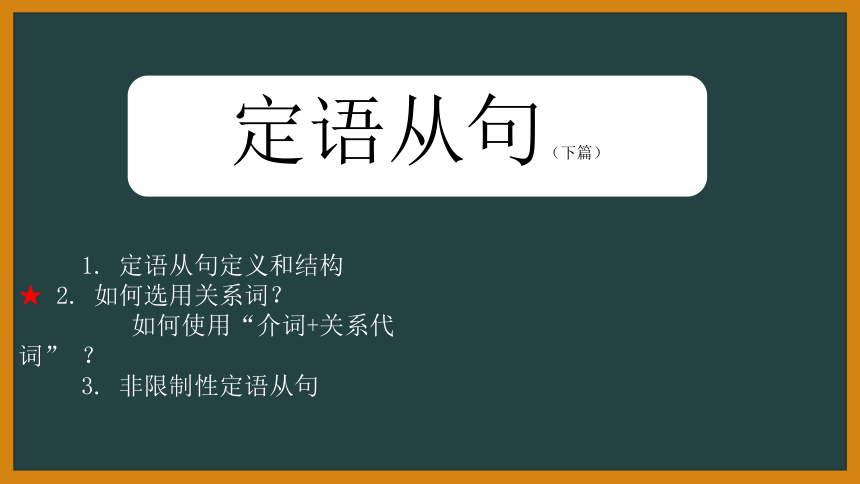 | |
| 格式 | pptx | ||
| 文件大小 | 1.6MB | ||
| 资源类型 | 教案 | ||
| 版本资源 | 通用版 | ||
| 科目 | 英语 | ||
| 更新时间 | 2022-04-12 16:39:19 | ||
图片预览

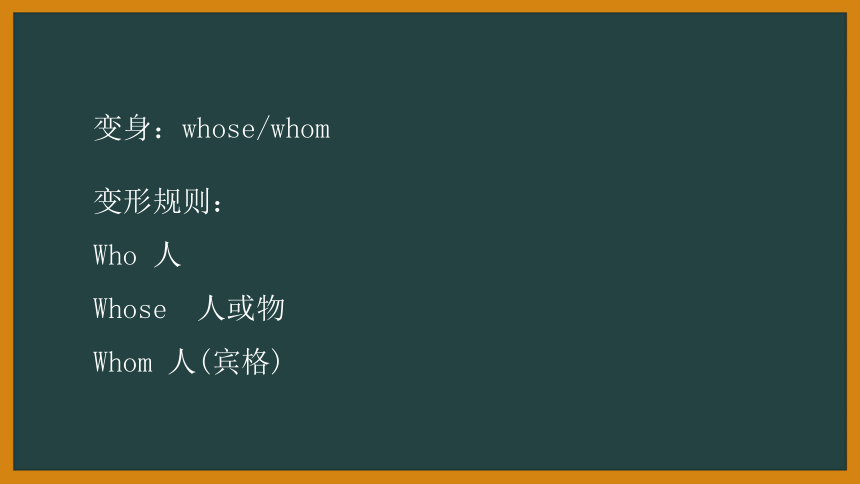
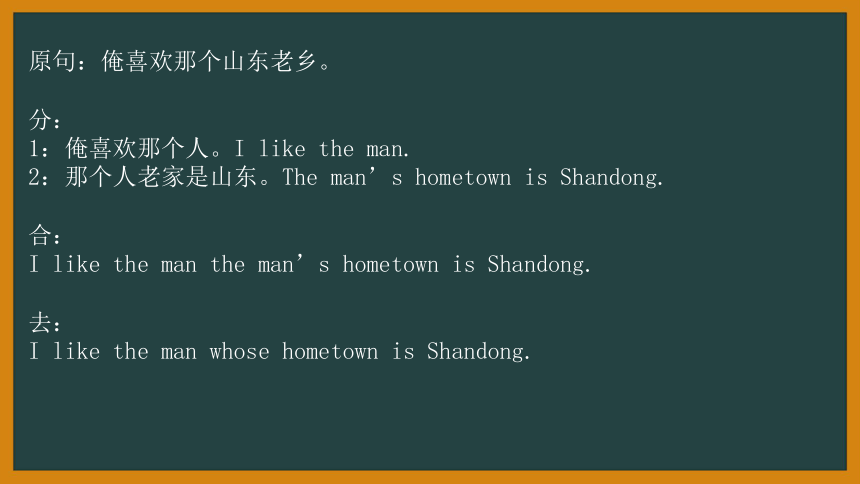
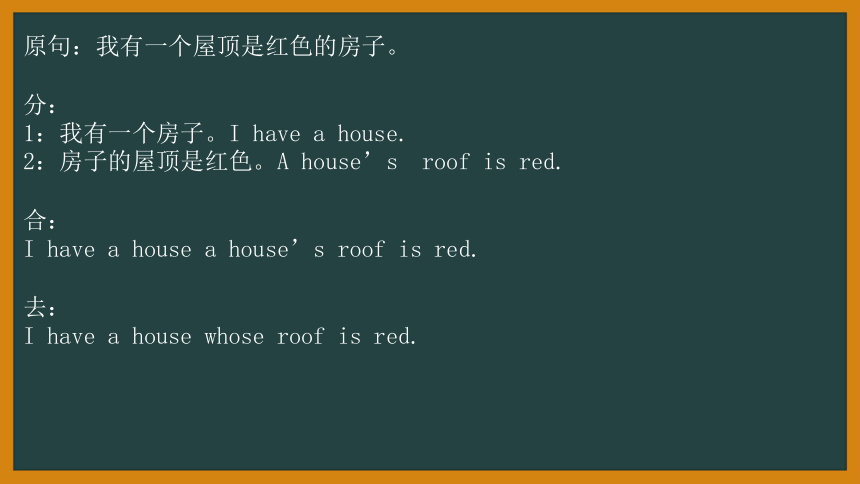
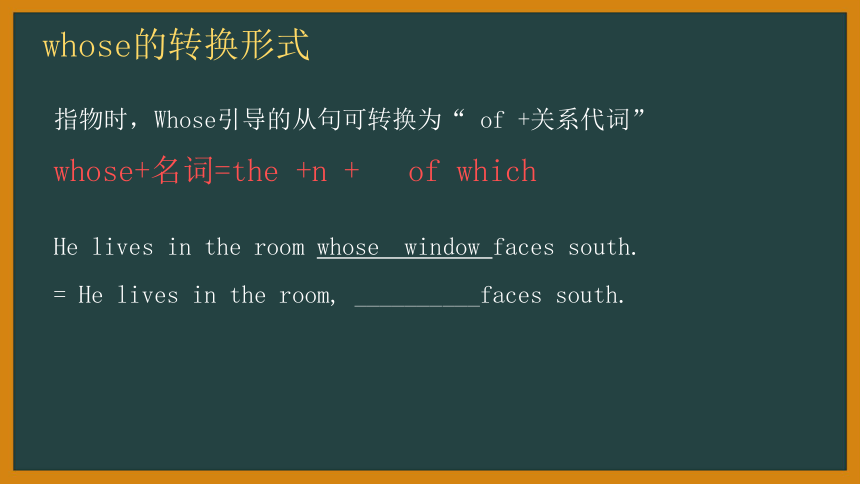
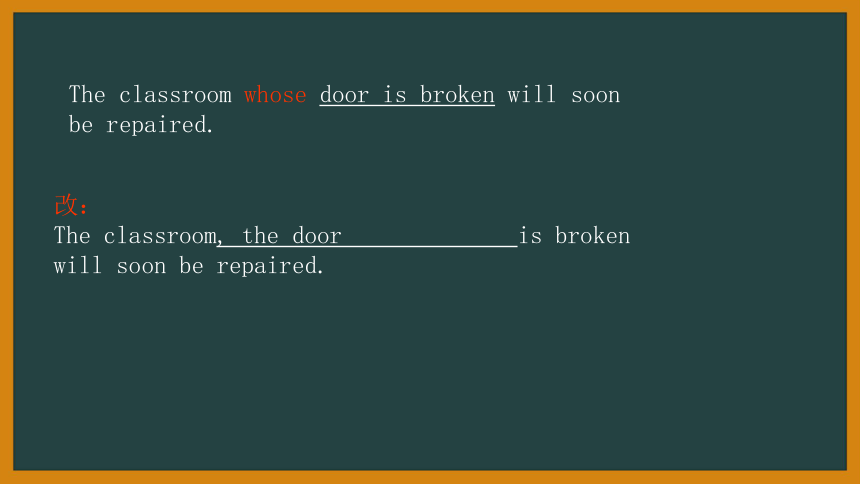
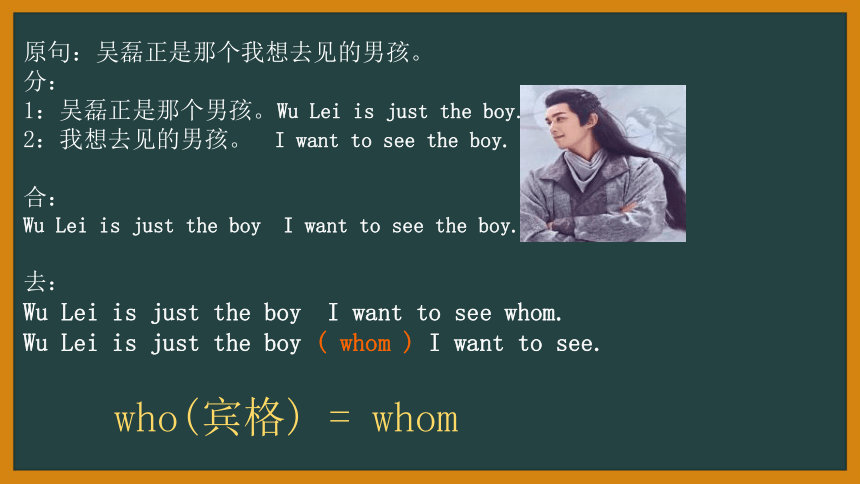
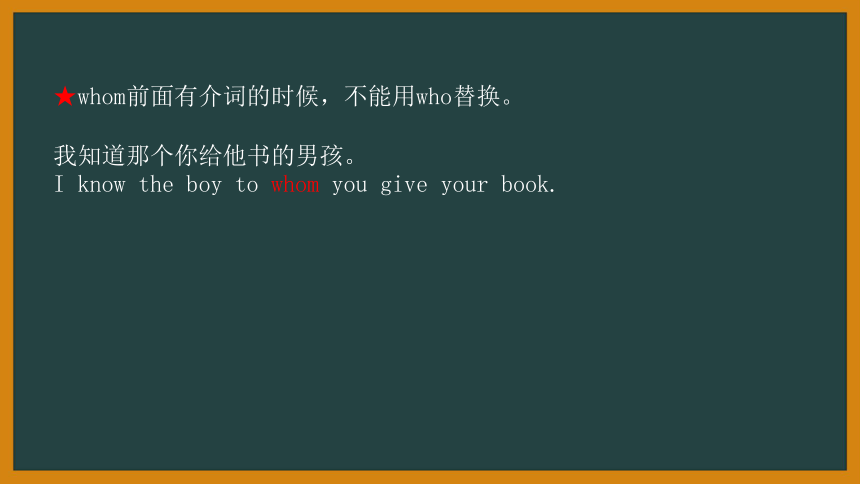
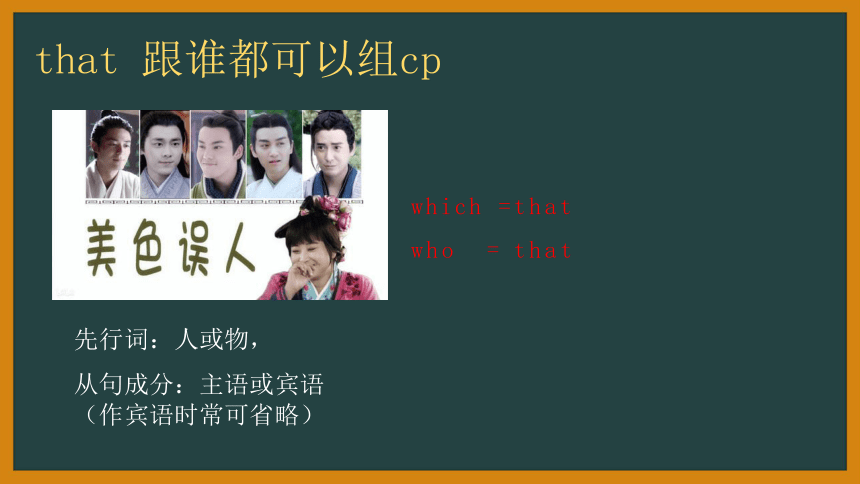
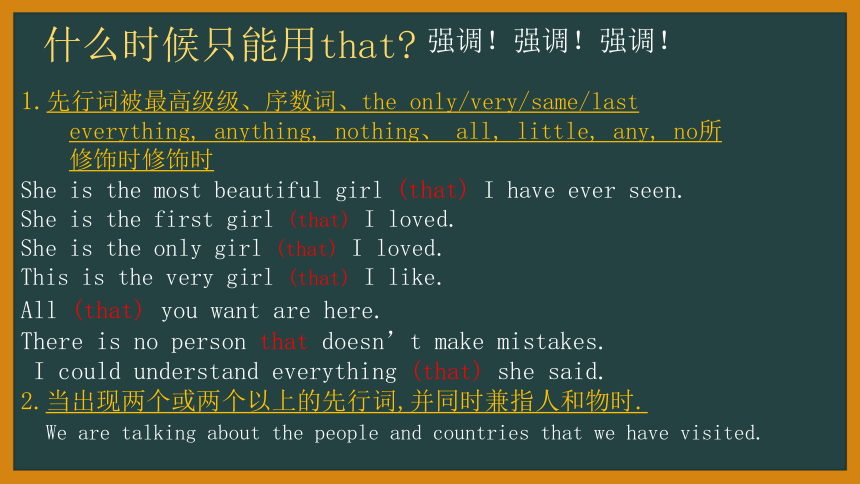
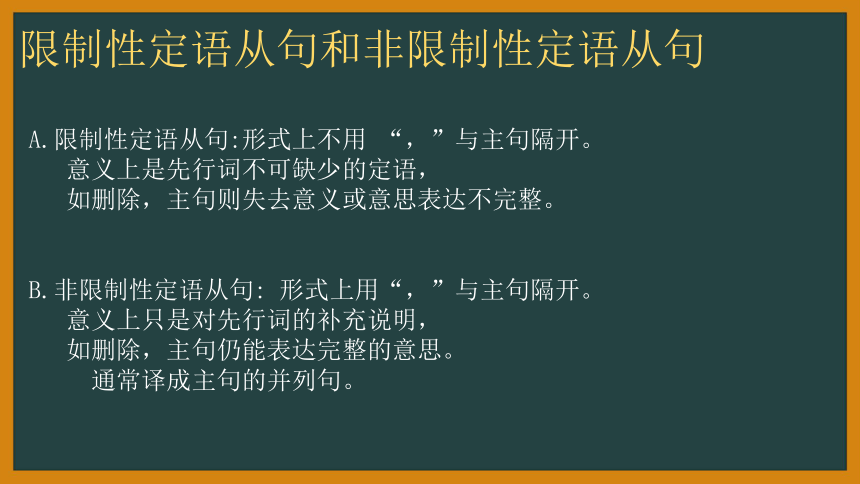
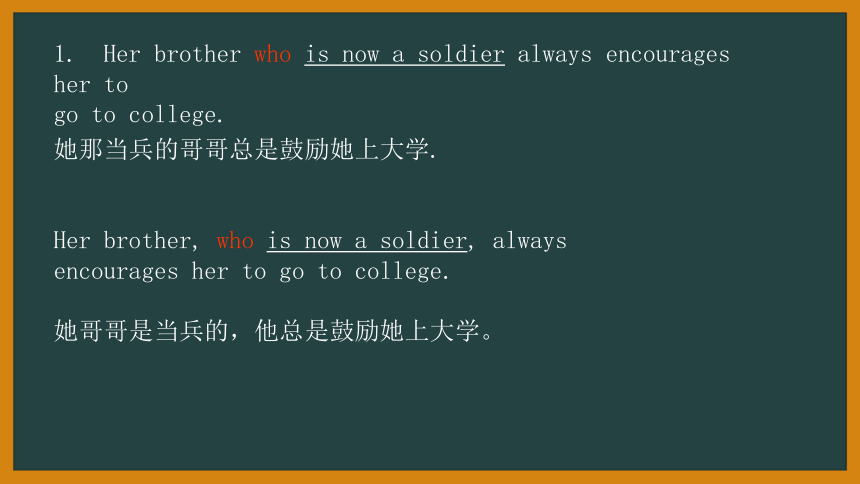
文档简介
(共33张PPT)
定语从句(下篇)
1. 定语从句定义和结构
★ 2. 如何选用关系词?
如何使用“介词+关系代词” ?
3. 非限制性定语从句
变身:whose/whom
变形规则:
Who 人
Whose 人或物
Whom 人(宾格)
原句:俺喜欢那个山东老乡。
分:
1:俺喜欢那个人。I like the man.
2:那个人老家是山东。The man’s hometown is Shandong.
合:
I like the man the man’s hometown is Shandong.
去:
I like the man whose hometown is Shandong.
原句:我有一个屋顶是红色的房子。
分:
1:我有一个房子。I have a house.
2:房子的屋顶是红色。A house’s roof is red.
合:
I have a house a house’s roof is red.
去:
I have a house whose roof is red.
指物时,Whose引导的从句可转换为“ of +关系代词”
whose+名词=the +n + of which
He lives in the room whose window faces south.
= He lives in the room, __________faces south.
whose的转换形式
The classroom whose door is broken will soon be repaired.
改:
The classroom, the door is broken will soon be repaired.
原句:吴磊正是那个我想去见的男孩。
分:
1:吴磊正是那个男孩。Wu Lei is just the boy.
2:我想去见的男孩。 I want to see the boy.
合:
Wu Lei is just the boy I want to see the boy.
去:
Wu Lei is just the boy I want to see whom.
Wu Lei is just the boy ( whom ) I want to see.
who(宾格) = whom
★whom前面有介词的时候,不能用who替换。
我知道那个你给他书的男孩。
I know the boy to whom you give your book.
that 跟谁都可以组cp
先行词:人或物,
从句成分:主语或宾语(作宾语时常可省略)
which =that
who = that
什么时候只能用that
1.先行词被最高级级、序数词、the only/very/same/last
everything, anything, nothing、 all, little, any, no所
修饰时修饰时
She is the most beautiful girl (that) I have ever seen.
She is the first girl (that) I loved.
She is the only girl (that) I loved.
This is the very girl (that) I like.
All (that) you want are here.
There is no person that doesn’t make mistakes.
I could understand everything (that) she said.
2.当出现两个或两个以上的先行词,并同时兼指人和物时.
We are talking about the people and countries that we have visited.
强调!强调!强调!
限制性定语从句和非限制性定语从句
A.限制性定语从句:形式上不用 “,”与主句隔开。
意义上是先行词不可缺少的定语,
如删除,主句则失去意义或意思表达不完整。
B.非限制性定语从句: 形式上用“,”与主句隔开。
意义上只是对先行词的补充说明,
如删除,主句仍能表达完整的意思。
通常译成主句的并列句。
1. Her brother who is now a soldier always encourages her to
go to college.
她那当兵的哥哥总是鼓励她上大学.
Her brother, who is now a soldier, always encourages her to go to college.
她哥哥是当兵的,他总是鼓励她上大学。
I love my girlfriend, who is good to me.
我爱我的女朋友,她对我很好。
I love my girl friend who is good to me.
我爱那个对我很好的女朋友。
什么时候只能用which
1.引导非限制性定语从句
2. 代表整个句子的意思
He had passed the math exam, which made his father very happy.
3.介词+关系代词
This is the room in which my father lived last year.
4.先行词后面有插入语时,只用which,不用that。
Here is the English grammar book which, as I've told you, will help you improve your English.
The student is so clever in that he won the first in the match.
He did not love me for even one day, that made me sad.
介词后面不能接that
非限定性定语从句不能用that
Tomorrow I’ll bring here the magazine
(which / that) you asked for.
Tomorrow I’ll bring here the magazine
for which you asked.
先行词:人或物, 从句成分:主语或宾语
such+名词+ as
such(pron.)+ as
the same +名词 + as
He is such a person as is respected by all of us.
This is the same pen as I lost yesterday.
This book is not such as I expect.
as
注意:当先行词受the same 修饰时,偶尔也用 that引导定语从句,但与as引导的定语从句意思有区别。
She wore the same dress that she wore at Mary’s wedding.
She wore the same dress as her younger sister wore.
as和which 引导的非限制性定语从句
相同之处:
1. 都可以在定语从句中做主语或宾语,代表前面整个句子。
He married her, as / which was natural.
He is honest, as / which we can see.
不同之处:
2.位置 as 可以放在主句之前、后,甚至可以分割主句。
另外,as “正如、正像”
which引导的非限制性定语从句只可放在主句之后。
He is from the south, as we can know from his accent.
John, as you know, is a famous writer.
Zhang Hua has been to Paris more than ten times, which I don’t believe.
As is known to all, China is a developing country.
3. 因果关系,往往只用which。
Tom was late for school again and again, which made his teacher very angry.
These tables are made of metal, which made them very heavy.
4.先行词作主语且定语从句为被动语态时,
只能用as.
be known, be said, be reported,
be announced, be mentioned 等
She has been absent again, as is expected.
关系副词 where
先行词由明显的地点—— 地点的模糊化
事实上,where 不能只理解为表地点。
当先行词为situation,case,stage, point等,
且定语从句不缺成分,用where。
They have reached the point where they have to separate with each other.
I can think of many cases where you know nothing about.
the way
为先行词的限制性定语从句
通常由in which或that引导,而且通常可以省略。
The way (that / in which/不填 ) he answered the questions was surprising.
The way ( that/ which/ 不填)he explained to us was quite simple.
同位语从句与定语从句
相似之处
1、两种从句都可以译成定语
The news that our team has won the final match
is encouraging. (同位语从句)
我们队取得决赛胜利的消息令人鼓舞。
The news that you told us is really encouraging.
(定语从句)你告诉我们的消息真的令人鼓舞。
相似之处
2、两种从句都可以用that引导
e.g.
The suggestion that students should learn something practical is worth considering. (同位语从句)
学生应该学些实用的东西的建议值得考虑。
The suggestion that is worth considering is that the students should learn something practical. (定语从句)
值得考虑的建议是学生应该学些实用的东西。
不同之处
1、从句的作用不同:同位语从句用来进一步
说明前面名词的内容;定语从句用来修饰、
限定前面的名词。
The news that our team has won the final match is encouraging.
从句说明“消息”的内容:我们队取得了决赛胜利。
The news that you told us is really encouraging.
从句对“消息”加以限定:
是你告诉我们的,而非来自其他渠道。
消息是何内容却不得而知。
不同之处
2、引导从句的关联词that的功能不同:that引导同位语从句时是一个纯连词,不充当任何成分;而引导定语从句的that是关系代词,既指代先行词又须在从句中充当成分。
Dad made a promise that he would buy me CD player if I passed the English test. (that 不充当任何成分)
Dad made a promise that excited all his children.
(that指代promise,又在从句中充当主语。)
The news that he told me is true.
The news that he has just died is true.
The problem that we are facing now is how we can collect so much money.
The problem how we can collect so much money is difficult to solve.
小结:
1. 定语从句定义和结构
★ 2. 如何选用关系词?
如何使用“介词+关系代词” ?
3. 非限制性定语从句
温
示
提
馨
本节结束,谢谢观看!
定语从句(下篇)
1. 定语从句定义和结构
★ 2. 如何选用关系词?
如何使用“介词+关系代词” ?
3. 非限制性定语从句
变身:whose/whom
变形规则:
Who 人
Whose 人或物
Whom 人(宾格)
原句:俺喜欢那个山东老乡。
分:
1:俺喜欢那个人。I like the man.
2:那个人老家是山东。The man’s hometown is Shandong.
合:
I like the man the man’s hometown is Shandong.
去:
I like the man whose hometown is Shandong.
原句:我有一个屋顶是红色的房子。
分:
1:我有一个房子。I have a house.
2:房子的屋顶是红色。A house’s roof is red.
合:
I have a house a house’s roof is red.
去:
I have a house whose roof is red.
指物时,Whose引导的从句可转换为“ of +关系代词”
whose+名词=the +n + of which
He lives in the room whose window faces south.
= He lives in the room, __________faces south.
whose的转换形式
The classroom whose door is broken will soon be repaired.
改:
The classroom, the door is broken will soon be repaired.
原句:吴磊正是那个我想去见的男孩。
分:
1:吴磊正是那个男孩。Wu Lei is just the boy.
2:我想去见的男孩。 I want to see the boy.
合:
Wu Lei is just the boy I want to see the boy.
去:
Wu Lei is just the boy I want to see whom.
Wu Lei is just the boy ( whom ) I want to see.
who(宾格) = whom
★whom前面有介词的时候,不能用who替换。
我知道那个你给他书的男孩。
I know the boy to whom you give your book.
that 跟谁都可以组cp
先行词:人或物,
从句成分:主语或宾语(作宾语时常可省略)
which =that
who = that
什么时候只能用that
1.先行词被最高级级、序数词、the only/very/same/last
everything, anything, nothing、 all, little, any, no所
修饰时修饰时
She is the most beautiful girl (that) I have ever seen.
She is the first girl (that) I loved.
She is the only girl (that) I loved.
This is the very girl (that) I like.
All (that) you want are here.
There is no person that doesn’t make mistakes.
I could understand everything (that) she said.
2.当出现两个或两个以上的先行词,并同时兼指人和物时.
We are talking about the people and countries that we have visited.
强调!强调!强调!
限制性定语从句和非限制性定语从句
A.限制性定语从句:形式上不用 “,”与主句隔开。
意义上是先行词不可缺少的定语,
如删除,主句则失去意义或意思表达不完整。
B.非限制性定语从句: 形式上用“,”与主句隔开。
意义上只是对先行词的补充说明,
如删除,主句仍能表达完整的意思。
通常译成主句的并列句。
1. Her brother who is now a soldier always encourages her to
go to college.
她那当兵的哥哥总是鼓励她上大学.
Her brother, who is now a soldier, always encourages her to go to college.
她哥哥是当兵的,他总是鼓励她上大学。
I love my girlfriend, who is good to me.
我爱我的女朋友,她对我很好。
I love my girl friend who is good to me.
我爱那个对我很好的女朋友。
什么时候只能用which
1.引导非限制性定语从句
2. 代表整个句子的意思
He had passed the math exam, which made his father very happy.
3.介词+关系代词
This is the room in which my father lived last year.
4.先行词后面有插入语时,只用which,不用that。
Here is the English grammar book which, as I've told you, will help you improve your English.
The student is so clever in that he won the first in the match.
He did not love me for even one day, that made me sad.
介词后面不能接that
非限定性定语从句不能用that
Tomorrow I’ll bring here the magazine
(which / that) you asked for.
Tomorrow I’ll bring here the magazine
for which you asked.
先行词:人或物, 从句成分:主语或宾语
such+名词+ as
such(pron.)+ as
the same +名词 + as
He is such a person as is respected by all of us.
This is the same pen as I lost yesterday.
This book is not such as I expect.
as
注意:当先行词受the same 修饰时,偶尔也用 that引导定语从句,但与as引导的定语从句意思有区别。
She wore the same dress that she wore at Mary’s wedding.
She wore the same dress as her younger sister wore.
as和which 引导的非限制性定语从句
相同之处:
1. 都可以在定语从句中做主语或宾语,代表前面整个句子。
He married her, as / which was natural.
He is honest, as / which we can see.
不同之处:
2.位置 as 可以放在主句之前、后,甚至可以分割主句。
另外,as “正如、正像”
which引导的非限制性定语从句只可放在主句之后。
He is from the south, as we can know from his accent.
John, as you know, is a famous writer.
Zhang Hua has been to Paris more than ten times, which I don’t believe.
As is known to all, China is a developing country.
3. 因果关系,往往只用which。
Tom was late for school again and again, which made his teacher very angry.
These tables are made of metal, which made them very heavy.
4.先行词作主语且定语从句为被动语态时,
只能用as.
be known, be said, be reported,
be announced, be mentioned 等
She has been absent again, as is expected.
关系副词 where
先行词由明显的地点—— 地点的模糊化
事实上,where 不能只理解为表地点。
当先行词为situation,case,stage, point等,
且定语从句不缺成分,用where。
They have reached the point where they have to separate with each other.
I can think of many cases where you know nothing about.
the way
为先行词的限制性定语从句
通常由in which或that引导,而且通常可以省略。
The way (that / in which/不填 ) he answered the questions was surprising.
The way ( that/ which/ 不填)he explained to us was quite simple.
同位语从句与定语从句
相似之处
1、两种从句都可以译成定语
The news that our team has won the final match
is encouraging. (同位语从句)
我们队取得决赛胜利的消息令人鼓舞。
The news that you told us is really encouraging.
(定语从句)你告诉我们的消息真的令人鼓舞。
相似之处
2、两种从句都可以用that引导
e.g.
The suggestion that students should learn something practical is worth considering. (同位语从句)
学生应该学些实用的东西的建议值得考虑。
The suggestion that is worth considering is that the students should learn something practical. (定语从句)
值得考虑的建议是学生应该学些实用的东西。
不同之处
1、从句的作用不同:同位语从句用来进一步
说明前面名词的内容;定语从句用来修饰、
限定前面的名词。
The news that our team has won the final match is encouraging.
从句说明“消息”的内容:我们队取得了决赛胜利。
The news that you told us is really encouraging.
从句对“消息”加以限定:
是你告诉我们的,而非来自其他渠道。
消息是何内容却不得而知。
不同之处
2、引导从句的关联词that的功能不同:that引导同位语从句时是一个纯连词,不充当任何成分;而引导定语从句的that是关系代词,既指代先行词又须在从句中充当成分。
Dad made a promise that he would buy me CD player if I passed the English test. (that 不充当任何成分)
Dad made a promise that excited all his children.
(that指代promise,又在从句中充当主语。)
The news that he told me is true.
The news that he has just died is true.
The problem that we are facing now is how we can collect so much money.
The problem how we can collect so much money is difficult to solve.
小结:
1. 定语从句定义和结构
★ 2. 如何选用关系词?
如何使用“介词+关系代词” ?
3. 非限制性定语从句
温
示
提
馨
本节结束,谢谢观看!
